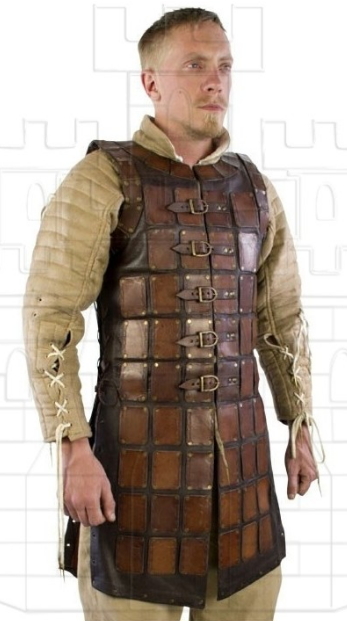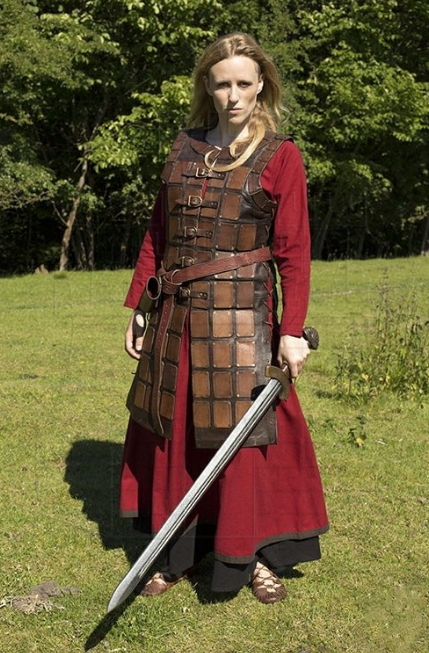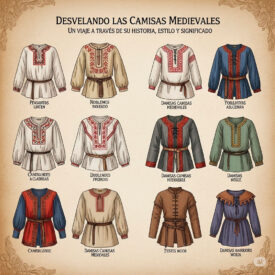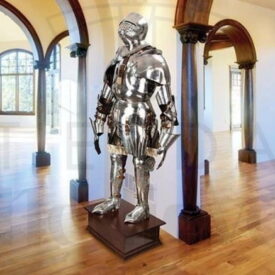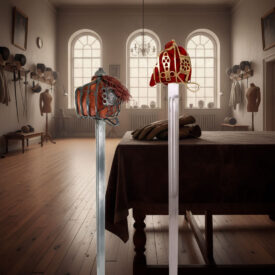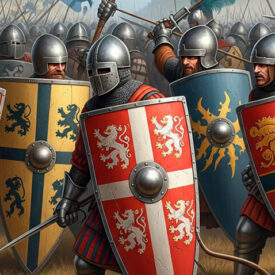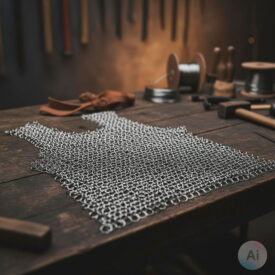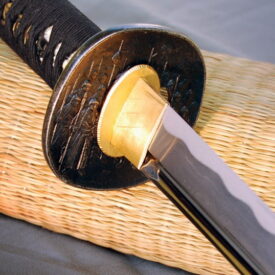The Middle Ages was a period of constant innovation in the art of war, and defensive armor was one of its most fascinating expressions. Between chainmail and full plate armors, a protective piece arose that combined the best of both worlds: the brigandine. This ingenious armor not only offered excellent protection, but also allowed for surprising mobility, making a key difference on the battlefield and, interestingly, even in the men’s fashion of the time. Are you ready to discover why the brigandine was a masterpiece of medieval military engineering? Join us on this journey!
Origins and Evolution: A Step Forward in Protection
The brigandine made its appearance in the 14th century, emerging as a natural evolution of earlier forms of protection such as the “coat of plates” or “plate coat.” Unlike the rigid armors we often imagine, the brigandine offered a more flexible and lighter alternative.
A common myth about its name is that it comes from “brigand,” suggesting it was the preferred armor of criminals. However, the definition of “brigand” at that time referred to a foot soldier, making it clear that the brigandine was widely used by professional soldiers and even by the European aristocracy. Its practicality and ease of repair made it popular among knights and nobles as well as the infantry. Originally, this type of jacket was only worn by foot soldiers, and those who first used it were bandits, brigands. Once its construction was perfected, the lords adopted it, as it served as both a breastplate and a coat of arms, being less expensive than white harnesses.
A brigandine is a breastplate used in the 14th and 16th centuries, made up of small steel scales riveted onto a strong fabric, canvas, or leather. War brigandines could be distinguished from tournament ones by the way they were fastened—the former on the chest and the latter on the right side.
Ingenious Design: Beyond Appearances
What truly set the brigandine apart was its unique and clever construction. It consisted of small metal plates (iron or steel) overlapped and riveted to the inside of a sturdy garment that could be made of strong fabric (like canvas or hemp) or leather. From the outside, it could look like a doublet or a regular cloth garment, but it hid a solid defense beneath.
The outer layer of the brigandine was often made of rich fabrics like velvet or brocade for high-ranking soldiers, while common fighters used simpler materials. The plates were strategically arranged to absorb and distribute the force of strikes, behaving like scales. The brigandine was a body defense made of iron, steel, or leather sheets placed like shingles and nailed to a bodice of cloth or leather, covered in velvet or silk over which the golden and even chiseled heads of the rivets stood out.
The inside of the bodice would show the bottom rivet of the small nails made on metal washers. Afterwards, this interior was covered with a simple fabric or leather. The oldest examples are from the second half of the 14th century. They were long, going down to the knees, without marking the waist. At the beginning of the 15th century, they were shortened and took on a more elegant shape with full sleeves.
The rivets that could be seen from the outside were not mere decorations. They were the key points that joined the metal plates to the fabric or leather lining, safely holding the whole structure together. These rivets were often decorative and could even be silvered or gilded for the wealthiest brigandines. The design allowed for considerable flexibility, crucial for mobility in combat, while maintaining a high level of protection against cuts and thrusts. A significant advantage was its modular nature: if a plate was damaged, it could be replaced without having to discard the entire armor, which made it very practical for long campaigns.

Protection and Mobility in Medieval Combat
The brigandine was highly valued for its balance between protection and agility. It allowed soldiers to move more freely compared to those wearing full plate armor, facilitating complex maneuvers and quick reactions in the heat of battle. It was particularly effective against the weapons of the time. Its overlapping plates offered excellent resistance to cutting attacks and could deflect or absorb the impact of arrows and blunt weapons. For this reason, it was a popular choice among infantry and light cavalry. Figures such as English archers during the Hundred Years’ War—a conflict that spanned from 1337 to 1453—often wore brigandines.
Underneath the brigandine and other armor, garments such as the woolen gambeson or the cotton doublet were worn. These inner layers separated the body from the metal, absorbed blows, and helped mitigate sweat.
The Impact on the Male Silhouette
Beyond the battlefield, the defensive panoply of medieval knights had an unexpected and profound cultural consequence—the separation between male and female clothing. The need to fit metal plates to the warrior’s body led to a more defined, contoured male silhouette, in contrast to women’s clothing, which remained looser. Over time, military attire began to influence everyday fashion. The tight garments worn underneath armor, such as pants and shirts, started to be used in daily life. This led men to leave behind long tunics for more practical garments that offered greater mobility, while long dresses remained predominantly reserved for women. Thus, at the end of the Middle Ages, military garb also became a symbol of power and luxury, with richly decorated armor even worn in parades and court events to demonstrate virility and status.
Evolution and Comparison with Other Armors
The brigandine was not the only type of armor that evolved. In the 13th century, gauntlets (for the hands) and cuisses (armor for the lower limbs made from metal or hardened leather) appeared. By the middle of the 13th century, the pourpoint—a silk or cloth garment worn over the chainmail, which also had an aesthetic function with heraldic motifs—helped protect against the sun and high temperatures as well.
In the 14th century, plate armor riveted onto cloth or leather began to replace chainmail, which was only kept in specific areas such as the armpits for stretchability. The gorget was fitted around the neck for protection, and metal sheet gauntlets replaced mail gauntlets. For the feet, shoes with articulated metal plates were developed, similar to gauntlets. Milan stood out as a leading center for high-quality brigandine manufacture, which later spread throughout Europe.
The Brigandine vs. Lamellar Armor
When compared to lamellar armor, both are types of armor made up of small, articulated plates, giving them flexibility. The key difference lies in how the plates are joined: in lamellar armor, the plates are laced or tied (typically with leather, hemp, or linen). In a brigandine, the plates are riveted to an inner layer of fabric or leather. Impact tests suggest that, while lamellar armor may absorb energy by breaking its bindings, the brigandine offered good overall protection, with the rivets holding the plates safely in place even under impact.
The Brigandine Today: Legacy and Recreation
The brigandine is not just a historical piece. It has left a significant mark on medieval culture, appearing in numerous manuscripts and works of art as the preferred armor of soldiers and knights. Notable examples can be seen in the miniatures of the Cantigas de Santa María by Alfonso X the Wise. Today, the brigandine continues to capture the imagination. It is exhibited in world-renowned museums such as the Metropolitan Museum of Art in New York and the Royal Armouries in Leeds. Its presence in films, TV shows, and historical re-enactments helps bring medieval battles to life. Moreover, its design principles, such as the use of overlapping plates for body protection, are applied in modern protective equipment.
In historical re-enactment and LARP, the brigandine is a popular option due to its authenticity and functionality. Its care and maintenance, such as regular cleaning and protection against rust, are crucial for its longevity. It was a symbol of ingenuity and adaptability in the Middle Ages. Its balance of protection, flexibility, and ease of repair made it an invaluable asset on the battlefield, and its legacy endures to this day.
Interested in having your own brigandine? Discover our selection of functional and decorative brigandines. You can also explore other body protection options like our breastplates and other armors to complement your medieval gear.

